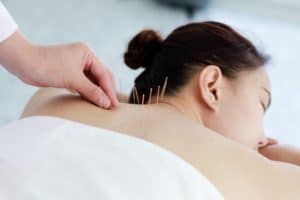Most modern-day Westerners don’t realize that many medicinal herbs are also foods, or that certain foods possess medicinal qualities. Nutritional therapy has historically played an important role in Chinese herbal medicine and continues to do so today. Many ordinary Chinese people continue to pass along folk knowledge of the medicinal properties of common foods, herbs, and seasonings used in everyday Chinese cooking. Chinese cuisine includes many traditional recipes that are intended to be curative, such as poultry tonic. Let’s take a closer look at five common and familiar herbs and their medicinal qualities, as well as some simple ways to use them.
1. Garlic
Garlic’s notorious aroma is simply one of those smells I will always associate with my years of living in northern China, where garlic is a culinary staple. During the frigid winters, marketplace eateries would offer up a dish of raw, peeled garlic cloves on the table, along with a steaming plate of boiled dumplings, to support customers’ immune health in fighting off colds. Everyone wanted to stay well. I recall stepping into a Chinese taxi where the driver kept a quart jar of raw garlic cloves on the dashboard, which he kindly offered to his customers.
Garlic also supports digestive health. My Tai Ch’i master in Beijing suffered from life-long stomach ailments after surviving the famine of China’s Great Leap Forward. He would often chew raw garlic cloves, and he highly recommended garlic as a remedy for digestive maladies.
A member of the Allium family, which includes chives, onions, leeks, and other food plants, garlic is a culinary and medicinal herb used across many cultures from east to west. Pliny the Elder, a Roman who lived from 23-79 A.D., recommended garlic as an antidote to poisoning and snake bites, and touted its abilities to serve as a cough suppressant and to expel parasites. These uses were similar to the way garlic was used in China as well.
Called Da Suan 大 蒜 in Mandarin Chinese, garlic’s first recorded use in Chinese medicine dates back to 510 A.D. Garlic is largely considered a folk remedy and is still widely used today. Chinese herbal medicine often uses garlic to address the following ailments:
- Kill parasites
- Remove toxins
- Serve as an antibacterial agent
- Treat diarrhea and dysentery
- Ease suffering caused by poor appetite or poor digestion
- Ease stomach pain
- Prevent and combat colds and tuberculosis
- When used as a poultice, treat external afflictions, such as pinworms, fungal infections, carbuncles, swellings, and snake bites
- Aid with digestion
Western scientific research has shown that garlic possesses antibacterial and anti-fungal properties. It has also been shown to prevent blood from clotting, to lower blood pressure, and to lower cholesterol. Clearly, consuming garlic is beneficial for cardiovascular health, as are its traditional uses for preventing colds and other infections. Nutritionally, garlic is rich in many vitamins and minerals, especially calcium, phosphorus, iron, thiamin, riboflavin, and vitamin C.
2. Ginger
Medicinal and culinary ginger (Zingiber officinale) is a member of the Ginger family, which includes other wild spices. Ginger has been cultivated in both China and India for millennia; in fact, its exact origins are unknown. Europe has used ginger for at least two thousand years, as there are references to it in Greek and Roman historical texts.
In Chinese, ginger is either called sheng jiang 生 薑 (fresh ginger) and gan jiang 乾 薑(dried ginger). Both dried and fresh ginger are seen as distinct medicinal products. The word “jiang” means “to defend,” which hints at the medicinal use of ginger for warding off illness. Energetically, ginger has warming properties (Chinese medicine classifies herbs as “warm” or “cool”).
Fresh ginger is used to expel pathogens, as well as for its diaphoretic properties (inducing sweating) that help to ward off colds and the flu. Fresh ginger can also help quell vomiting, nausea, and an upset stomach. To use fresh ginger most effectively, you can make a fresh ginger tea by peeling and grating a half-inch of fresh ginger, boiling it with 12 ounces of water for about 5 minutes, and adding honey or lemon to taste.
Dried ginger is used primarily as a digestive aid. It can also help encourage circulation to the extremities when they are feeling too cold. Ginger’s uses in Ayurvedic medicine and Western folk medicine are similar to those of Chinese herbalists; its qualities as a digestive aid are legendary.
Modern research on ginger has been extensive and indicates a wide range of bioactive qualities, such as: antibacterial, anticonvulsant, analgesic, antispasmodic, anticoagulant, and more. Ginger is safe, readily available, inexpensive, and delicious–what’s not to like? Humans and ginger have been together for a very long time, and there’s no doubt that this relationship will continue.
3. Mint
There are over 500 species of mint, all of which have similar medicinal properties and tastes. Chinese medicine uses mint (called bo he 薄 荷 in Chinese) for a variety of reasons, including:
- Treating the common cold, especially a sore throat (what the Chinese call “Wind Heat” illness)
- Providing relief from headaches, eye irritation, and itching
- Cooling properties (as opposed to ginger’s warming properties)
- Easing pain associated with sore eyes
Chinese herbal medicine often includes mint in a formula with other herbs to treat a cold. However, dried or fresh mint can be prepared as a soothing, delicious tea at home to provide some relief. For a headache, you can apply a few drops of peppermint essential oil to your temples, which can ease the pain.
Research shows that mint has antibacterial and antiviral properties. It also increases the flow of mucus, which is helpful for relieving cold symptoms. In Western herbalism, peppermint is recommended as a common digestive aid, which interestingly is not one of its primary uses in Chinese herbal medicine.
4. Turmeric
Turmeric (jiang huang 薑 黃 in Chinese, meaning “ginger yellow”), is in the ginger family. It is often confused with a related Chinese herb, Yu jin, which shares some, but not all, medicinal properties associated with common turmeric. Used in both China and India for thousands of years, turmeric is known as the “golden spice” for its famous brilliant color. Turmeric has recently become popularized in the West for its anti-inflammatory and circulatory properties, demonstrated through a variety of published research.
The active ingredient in turmeric is curcumin, which is absorbed through the digestive tract. To increase absorption, combine turmeric with a small amount of black pepper (which contains piperine) and beneficial fats such as coconut oil. Another way of ingesting the benefits of turmeric is by preparing a turmeric tea originating from Ayurvedic medicine, called golden milk. While there are many variations of this tea, each recipe should include a small amount of black pepper and ginger along with the turmeric. Fresh ginger and turmeric roots are best to use in making golden milk.
Chinese medicine uses turmeric to ease a variety of conditions and ailments, including:
- Arthritis and joint pain
- Menstrual cramps and blood clots
- Abdominal pain
- Trauma, such as swelling and bruising
- Circulatory problems
- General pain relief
According to Pharmacology and Applications of Chinese Materia Medica and Chinese Herbal Medicine Materia Medica (14), in laboratory animal studies, turmeric has been shown to:
- Reduce blood lipids
- Improve blood circulation to the heart
- Lower blood pressure
- Reduce platelet aggregation and promote fibrinolysis (break down blood clots)
- Increase bile formation and secretion
- Reduce inflammation
- Alleviate pain
- Stimulate uterine contraction
In clinical trials, turmeric was used to reduce blood lipids, treat angina pectoris, alleviate stomach ache, remove gallstones, treat jaundice, and relieve postpartum pain.
5. Honey
A culinary herb, honey is often included in preparing certain medicinal herbal formulas. Honey (called feng mi 蜂 蜜 in Chinese) aids weak digestive function and can make herbal preparations easier to digest. It has strong moistening properties, making it effective in treating chronic dry cough. In effect, it functions as a natural cough syrup. Additionally, honey can help with constipation created by dryness, as it can smooth and soften the stools. With its long-recognized antibiotic and anti-inflammatory properties, honey has been used in both Western and Chinese folk medicine practices as a poultice to cover wounds and treat burns.
Whenever possible, choose raw, local, organic honey, as processing and filtering the honey changes its properties and destroys many of its benefits. Choosing local honey may also help prevent seasonal allergies, since local honey contains very small amounts of local allergens.
Nutritionally, raw honey is a power food that, while high in sugars, is still a healthier way to include sweetness in your diet. Raw honey is an excellent source of vitamins, minerals, and antioxidants. Choosing honey over other sugars and sweeteners allows you to enjoy a hint of sweetness while avoiding the many unhealthy properties of processed foods with added sugars. However, remember to indulge sparingly; although honey is lower on the glycemic index than refined sugar, honey still contains plenty of calories!
Useful and Versatile Pantry Staples
These five common household staples offer plenty of nutritional and curative benefits. We at Inner Works Acupuncture are happy to share more information with you about the versatile properties of foods, medicines, and herbs, so please contact us today to learn more about how we can support the health of your body, immune system, mind, and spirit.




